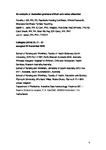An analysis of Australian graduate critical care nurse education
| dc.contributor.author | Gill, Fenella | |
| dc.contributor.author | Leslie, GD | |
| dc.contributor.author | Grech, C | |
| dc.contributor.author | Latour, Jos M | |
| dc.date.accessioned | 2017-01-21T10:24:10Z | |
| dc.date.available | 2017-01-21T10:24:10Z | |
| dc.date.issued | 2015-03 | |
| dc.identifier.issn | 1322-7696 | |
| dc.identifier.issn | 1876-7575 | |
| dc.identifier.uri | http://hdl.handle.net/10026.1/8282 | |
| dc.description.abstract |
BACKGROUND: Preparation of specialist critical care nurses in Australia is at graduate level, although there remains considerable variation in courses offered in relation to qualification, content, assessment and outcomes. As higher education providers must now comply with the Australian Qualifications Framework (AQF) a study was conducted to examine existing critical care courses and graduate practice outcomes. METHODS: Twenty-two critical care courses were reviewed. Data sources included course provider, websites, course curricula and telephone interviews with course coordinators. A framework approach, was used consisting of five key stages: preliminary immersion of raw data, conceptualising a thematic framework, indexing, charting, mapping and interpretation of data. FINDINGS: Analysis revealed considerable variations in course delivery and graduate practice outcomes. Most courses used professional competency standards as a framework for course curricula and clinical assessment, with inconsistency in their translation to graduate practice outcomes. Twenty-one courses included clinical assessment at graduate certificate level with no clinical assessment conducted at master level. The expected practice outcome for fifteen courses was safe practice with graduates not expected to practice at a specialist or team leadership level. Minimum graduate practice standards were not included in three courses as an expected outcome. CONCLUSION: The AQF requires graduate nurse education to be compliant with academic outcome standards. The findings of our study indicate variations between courses and subsequent graduate practice outcomes. It is therefore timely to establish national critical care education graduate practice standards. | |
| dc.format.extent | 71-81 | |
| dc.format.medium | ||
| dc.language | en | |
| dc.language.iso | eng | |
| dc.publisher | Elsevier BV | |
| dc.subject | Intensive care | |
| dc.subject | Specialty nurse | |
| dc.subject | Practice outcomes | |
| dc.title | An analysis of Australian graduate critical care nurse education | |
| dc.type | journal-article | |
| dc.type | Journal Article | |
| plymouth.author-url | https://www.webofscience.com/api/gateway?GWVersion=2&SrcApp=PARTNER_APP&SrcAuth=LinksAMR&KeyUT=WOS:000353001600010&DestLinkType=FullRecord&DestApp=ALL_WOS&UsrCustomerID=11bb513d99f797142bcfeffcc58ea008 | |
| plymouth.issue | 1 | |
| plymouth.volume | 22 | |
| plymouth.publication-status | Published | |
| plymouth.journal | Collegian | |
| dc.identifier.doi | 10.1016/j.colegn.2013.11.006 | |
| plymouth.organisational-group | /Plymouth | |
| plymouth.organisational-group | /Plymouth/Faculty of Health | |
| plymouth.organisational-group | /Plymouth/Faculty of Health/School of Nursing and Midwifery | |
| plymouth.organisational-group | /Plymouth/REF 2021 Researchers by UoA | |
| plymouth.organisational-group | /Plymouth/REF 2021 Researchers by UoA/UoA03 Allied Health Professions, Dentistry, Nursing and Pharmacy | |
| plymouth.organisational-group | /Plymouth/Research Groups | |
| plymouth.organisational-group | /Plymouth/Research Groups/Institute of Health and Community | |
| plymouth.organisational-group | /Plymouth/Research Groups/Plymouth Institute of Health and Care Research (PIHR) | |
| plymouth.organisational-group | /Plymouth/Users by role | |
| plymouth.organisational-group | /Plymouth/Users by role/Academics | |
| dc.publisher.place | Australia | |
| dc.identifier.eissn | 1876-7575 | |
| dc.rights.embargoperiod | No embargo | |
| rioxxterms.versionofrecord | 10.1016/j.colegn.2013.11.006 | |
| rioxxterms.licenseref.uri | http://www.rioxx.net/licenses/all-rights-reserved | |
| rioxxterms.type | Journal Article/Review |


